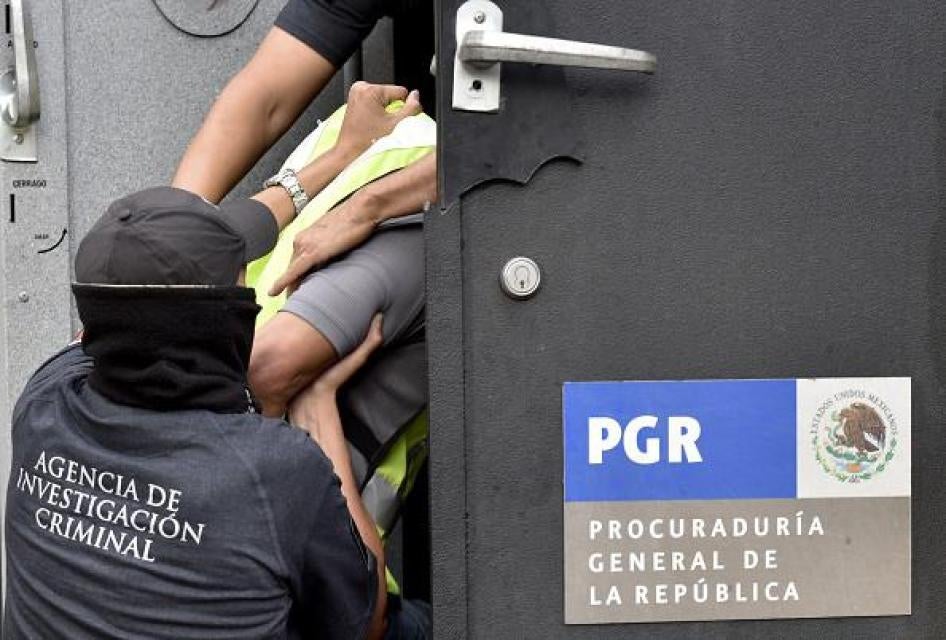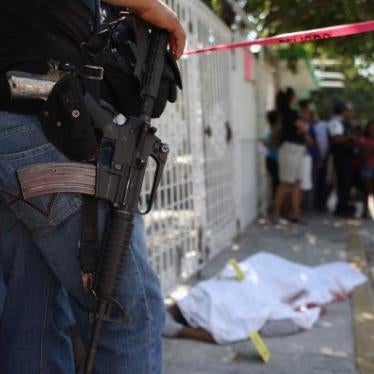The government sought to justify its attack on Méndez by claiming that his report cited only 14 specific cases of alleged torture. It’s possible that adding more concrete cases to complement the quantitative data and other information already included in the report could have made the findings even more convincing—if, indeed, anyone actually needed convincing. But, as the Peña Nieto administration knew perfectly well, there was ample evidence to back the UN expert’s conclusion.
In 2011, a year before Peña Nieto took office, Human Rights Watch (HRW) issued a comprehensive report on abuses by Mexican security forces that received extensive media coverage, including on the front pages of the country’s leading papers. We documented the systematic use of torture in more than 170 cases. Tactics varied: there were beatings, electric shocks, asphyxiation, death threats, sexual assault. So did the torturers: they were federal, state, and municipal police; soldiers and sailors; federal and state prosecutors.
And these were just the cases that a single researcher from our organization was able to document doing fieldwork in just five states. In 2013 and 2014 alone, the Federal Prosecutor’s Office received almost 2,000 reports of torture, while state human rights commissions received more than 6,000 complaints of torture or inhumane treatment. How many of these complaints were valid was impossible to know, as most were never properly investigated. Whatever the number of actual cases, the reports of torture that surfaced in the the months before Méndez presented his report were more than enough to make the government’s response seem patently absurd.
There was, for example, a February 2015 video—which subsequently went viral—showing federal police and soldiers asphyxiating a woman with a plastic bag and threatening to kill her. There was also the October 2014 report of the National Commission of Human Rights (CNDH) that detailed how state prosecutors in charge of “investigating” the killing of 22 civilians by soldiers in the Tlatlaya municipality had detained witnesses, beaten and asphyxiated them, and threatened to rape and kill them if they didn’t sign statements exonerating the military.
And then, of course, there was Ayotzinapa. In late 2014, faced with unprecedented public pressure to solve the case of the 43 students disappeared in Guerrero, the Federal Prosecutor’s Office constructed an official account of what had occurred based primarily on the self-incriminating testimony of detainees, a majority of whom showed signs of torture. According to a report published this year by the Office of the UN High Commissioner for Human Rights, more than 30 of these detainees had suffered abuse that included “beatings, kicks, electric shocks, blindfolding, attempted asphyxia, sexual assault, and various forms of psychological torture.” One detainee may have even been tortured to death. In a nationally-televised news conference, Attorney General Jesús Murillo Karam announced that the Attorney General’s Office had solved the case and described findings obtained through torture as “the historical truth,” a phrase that has come to represent the cynicism of the sexenio.
Naturally, the government's attacks on the UN expert on torture did not make the problem disappear. Over the course of 2015, state-level human rights commissions received almost 2,000 new torture complaints. The following year, the National Institute for Statistics and Geography (Instituto Nacional de Estadísticas y Geografía, INEGI) surveyed more than 64,000 people incarcerated in 338 Mexican prisons, more than 60 percent of whom had been arrested since 2012—the year in which Peña Nieto took office. Nearly two-thirds reported physical abuse by the authorities who detained them. More than a third reported being choked, held underwater, or smothered. A fifth—almost 13,000 —reported electrical shocks.
How many of these allegations were true? Again, in the absence of proper investigations, it’s impossible to know. But there are two things we do know that give reason to suspect the answer is many. One—illustrated by the Ayotzinapa and Tlatlaya cases—is that Mexican prosecutors believe they can use coerced statements to “resolve” criminal cases. Another is that they apparently believe they can get away with it. And with good reason: federal prosecutors have “opened” more than 9,000 investigations of alleged torture between when Peña Nieto took office in December 2012 and January 2018. According to the Prosecutor’s Office, during that period they had not obtained a single conviction.
If anything positive came out of the Ayotzinapa tragedy, it was the massive public outrage that forced Peña Nieto to take several extraordinary steps to address the country’s disastrous human rights situation. In late November 2014, he promised to pursue 10 measures to strengthen the rule of law. One was an anti-torture law, passed in April 2017, which contains provisions that, if implemented vigorously and in good faith, could indeed help curb this form of abuse. Among other things, the law strengthens existing prohibitions on the use of coerced confessions. It also mandates creating anti-torture units in prosecutors’ offices, at the state and federal level, as well as strengthening and giving autonomy to a national unit to monitor detention centers, where torture often occurs. The law thus aims to address the two factors that perpetuate the practice: authorities’ ability to use torture to “resolve” cases, and their ability to get away with it.
Of course, Mexico has a long history of creating laws and mechanisms to curb abuse that look good on paper but achieve little in practice. That is to be expected when the officials responsible for implementing these measures are more intent on denying the problems than solving them—as the Peña Nieto administration did in response to the Méndez report.
But denial may have become more difficult after Ayotzinapa—in large part because of a second extraordinary measure adopted by Peña Nieto. In response to the public outrage provoked by these heinous crimes, Peña Nieto invited the Inter-American Commission on Human Rights (IACHR) to send a team of investigators—the Interdisciplinary Group of Independent Experts —to examine the government’s handling of the case. The prosecutors’ work had never before been exposed to external scrutiny, and the findings were devastating.
In reports issued in 2015 and 2016, the international experts laid bare how the Ayotzinapa investigation succumbed to a toxic mix of incompetence, abuse and bad faith within the prosecutors’ office. And in so doing, the experts showed what local and international human rights experts—including Méndez—had been saying for years about the central role coerced confessions play in perpetuating impunity in Mexico.
The report by the UN high commissioner earlier this year provided even more damning evidence of the prosecutors’ mishandling of the case. In June, a 712-page federal appeals court ruling, concluded that the prosecutors could not be trusted to resolve the case and instructed the federal government to create a “Commission of Inquiry for Justice and Truth" to do the job.
Ayotzinapa will soon become Andrés Manuel López Obrador’s responsibility. The president elect has promised to establish a commission to examine the case. Undoubtedly, an investigation commission that could determine the fate of the missing students would certainly be worth the effort–even more so if it can pave the way to bring those responsible to justice.
But the tragedy of Ayotzinapa is, ultimately, larger than the fate of the students—larger even than the immense suffering of their families. The fact that this atrocity has yet to be resolved—despite the fact that the whole world had its eyes on it—is just one manifestation of Mexico’s broader failure to provide truth and justice to the many thousands of families whose loved ones have been disappeared or killed. The use of torture has been a central component of this failure.
Mexico desperately needs more effective law enforcement. Torture is its antithesis. It is a crime that serves to cover up other crimes. As Ayotzinapa, Tlatlaya, and other recent cases have made clear, torture does not produce truth. It compels victims to say whatever they think their tormentors want to hear in order to end what is meant to be unbearable suffering. Victims confess to crimes they didn’t commit. They falsely accuse—or exonerate—others. Innocent people are then prosecuted, while the true culprits remain at large. Torture thus perpetuates the impunity that allows crime and abuse to thrive.
López Obrador would do well to take several lessons from Ayotzinapa. The first is the urgent need to build an autonomous public prosecutor’s office that is capable of and committed to conducting serious investigations of—at a bare minimum—the worst atrocities by security forces and organized crime. This urgent obligation should be a key factor guiding the president-elect in the process of creating a new federal prosecutor’s office.
A second lesson is that ensuring serious investigations into atrocities and other crimes—and thereby the success of the new prosecutor’s office—will require combating and ending torture. This requires the full and vigorous implementation of the new torture law—including by making sure the national register of torture cases and the specialized prosecutor’s office for torture are operating as effectively as possible. But although the torture law required the PGR to have the infrastructure for the national register in place by December 2017, the PGR informed us in August 2018—eight months after the deadline had passed—that this task still had not been completed. Nor has it issued the national program against torture, as the law requires.
A third lesson that can be inferred from Ayotzinapa regards the vital role that three types of actors have played in exposing the state’s mishandling of the case: the victims’ families, local organizations, and international investigators. The debunked “historical truth” would almost certainly have prevailed were it not for the tireless efforts of the victim’s families to demand answers, the guidance and legal assistance that local human rights groups provided them to ensure that these demands were heard, and the investigations by the international experts as well other civil society organizations. The new administration should welcome and encourage ongoing participation of all of these groups to put an end to torture and impunity for human rights crimes in Mexico.
Daniel Wilkinson is the Americas managing director at Human Rights Watch.









